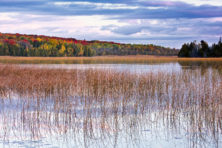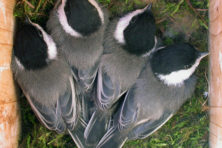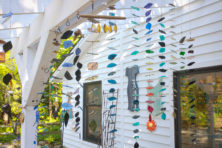Birds of Color
- Share
- Tweet
- Pin
- Share
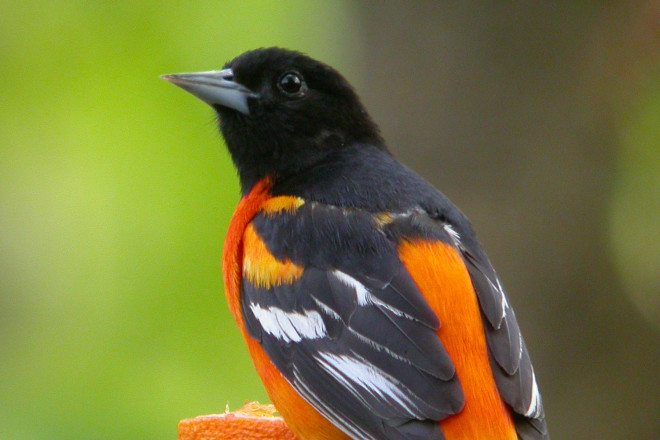
We in the north live in a monochromatic world most of the winter. Black, white and gray are the dominant colors, with leafless trees and snow-covered landscapes. Even many of the birds are black and white, such as the Chickadees, Juncos, Nuthatches and most Woodpeckers. Our only really 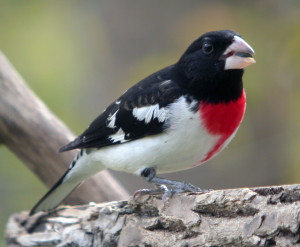 colorful birds here all year are the Cardinals, but they are not abundant and are only to be found in localized areas.
colorful birds here all year are the Cardinals, but they are not abundant and are only to be found in localized areas.
Fortunately we have the pines, spruces and firs to liven up the winter world with their colors. Once the snow has melted and small hints of green appear, I know exactly where to go on our property in search of the first wildflowers in bloom, the Hepaticas, and often that’s the time when we can expect to see and hear our favorite migratory birds returning.
Like old friends, the species that return in late April and May are some of our most colorful favorites. Rose-breasted Grosbeaks and Scarlet Tanagers are some of the brightest. One of the very earliest, the male Red-winged Blackbird, sports bright red-orange shoulder patches (or “epaulets”). A study done in the past indicated that male Red-wings with the deepest colored and largest patches were able to claim the best nesting and breeding areas, and naturally attracted more females.
Several years ago, during the peak of spring migration, Charlotte counted nine male Indigo Buntings grouped closely in our front yard, some at the birdbaths on the ground and others on the nearby platform feeders. Years ago we were fortunate to have a pair take up nesting in our raspberry patch near the tops of the canes at about waist level. How exciting it was to so easily watch their progress from day to day.
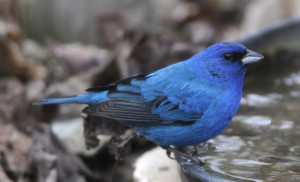 People tend to be disbelievers when told that Blue Jays, Indigo Buntings and Eastern Bluebirds lack blue pigment in their feathers. Their quick reply is, “Well, how come they look so blue then?” It all has to do with the air vesicles within the blue feather-barbs and the presence of dark pigment (melanin) situated beneath these air-filled, color-reflecting units, serving as an absorbing screen.
People tend to be disbelievers when told that Blue Jays, Indigo Buntings and Eastern Bluebirds lack blue pigment in their feathers. Their quick reply is, “Well, how come they look so blue then?” It all has to do with the air vesicles within the blue feather-barbs and the presence of dark pigment (melanin) situated beneath these air-filled, color-reflecting units, serving as an absorbing screen.
All the natural light falling on these feathers is absorbed except the blue rays, which have very short wave length. As a result, only the blue rays are reflected to our eyes. If you were to hold a blue feather up to the light (generally toward the sun) so as to receive transmitted rather than reflected light, the feather would appear gray or black. Make a 180-degree turn and view the feather away from the sun – it appears blue!
Years ago we visited our friends, Harold and Verna Wilson, who were wintering in Florida. Being a dedicated bird bander, Harold was banding birds the day we arrived. One of his captives turned out to be a brilliant male Painted Bunting decked out in a combination of blue, green, yellow and red, almost as though a committee that couldn’t make up its mind had designed it.
A few years later a bird accidentally flew into our opened garage and allowed me to easily capture it for a closer look and to take some pictures of it while being held in the hand. Imagine our surprise to learn that it was an immature male Painted Bunting, far out of its normal southerly range. Charlotte jokingly made the comment that perhaps the bird was looking for Harold Wilson!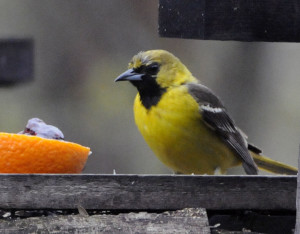
One of our friends was searching for morel mushrooms along the edge of a woods several years ago when he accidentally discovered a female Whip-poor-will nesting as they do on the ground. What a great lesson we had in appreciating the effectiveness of cryptic colors as we tried in vain to locate the bird for photographing, about as difficult as it was to distinguish the Killdeer’s eggs among the stones along a roadside.
As soon as the Baltimore Orioles return to the county this spring, make a point of seeing how many colors, feet and legs included, you can see on this flashy bird, especially on the more colorful male. Once in a while an Orchard Oriole appears on a feeder in northern Door County. This bird can range from yellow in the immature to a dark orange in mature adult males.
The bird whose return we patiently wait for is the Ruby-throated Hummingbird. The flaming gorget (GOR-jit), the red throat patch of the male, is so interesting and strikingly beautiful to study. When it is sitting in dim light or shadows the throat feathers look black. If the sun hits these feathers, they glow a brilliant sparkling red.
 Common Grackles seem to be nearly all black but in certain light you can see hints of iridescent purples, violets and blues in the feathers. Most birds in the blackbird group are dull black or brown.
Common Grackles seem to be nearly all black but in certain light you can see hints of iridescent purples, violets and blues in the feathers. Most birds in the blackbird group are dull black or brown.
One member that is more colorful is the Eastern Meadowlark, which nests in the field to the west of our home. Occasionally on a very early summer morning we’ll see the Meadowlark, perched on a large rock and facing toward the east, singing to the top of his voice as though it was greeting the day with the sun reflecting off its brilliant yellow breast.
Door County lays claim to many nesting species of sparrows: the White-throated, Song, Swamp, Chipping, Clay-colored, Vesper, Grasshopper, Savannah and Field. It takes a little study and effort to tell them apart by their plumage. All tend to be quite brownish with only small subtle field marks by which to differentiate them. Fortunately their songs are very distinctive and help with identification.
There is one sparrow, the colorful Fox Sparrow, which remains with us for only brief periods during its migratory flights. The cinnamon browns and gray streaks give beautiful contrasting hues to this elusive sparrow.
Apparently our property contains precisely the habitat that strongly appeals to the Scarlet Tanagers, 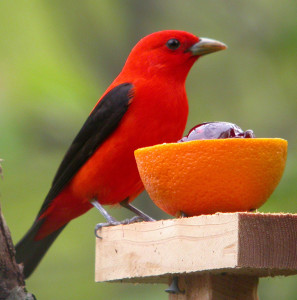 for they nest here every year. The dripping birdbath that we provide as soon as the weather warms is greatly to the Tanagers’ liking. They accept very quickly the photographing blind I set up a dozen feet from the birdbath. Some of my favorite bird-bathing pictures are of the Scarlet Tanagers, so thoroughly soaked to the skin that I wonder how they can fly.
for they nest here every year. The dripping birdbath that we provide as soon as the weather warms is greatly to the Tanagers’ liking. They accept very quickly the photographing blind I set up a dozen feet from the birdbath. Some of my favorite bird-bathing pictures are of the Scarlet Tanagers, so thoroughly soaked to the skin that I wonder how they can fly.
A southern breeding bird has visited Door County on several occasions. The Summer Tanager is sometimes in a transition plumage and it makes for real excitement to see one in the yard. The young males can be a combination of reds and yellows, but they usually don’t stay for more than a few weeks in spring.
Once the Baltimore orioles and Rose-breasted Grosbeaks begin nesting, their brilliant far-reaching songs lace the woods with beauty and serenity. Spring and summer, rich with the delicate musical arias of these and other nesting birds, keeps Charlotte and me close to home!

